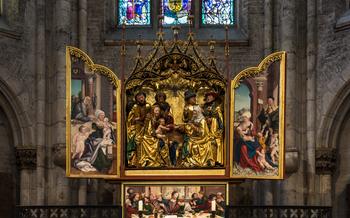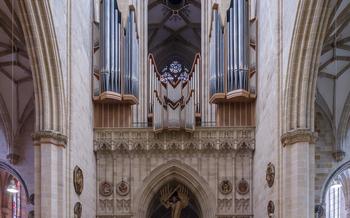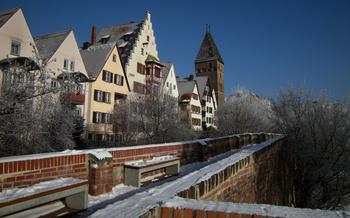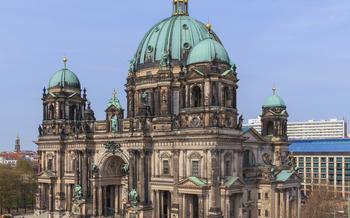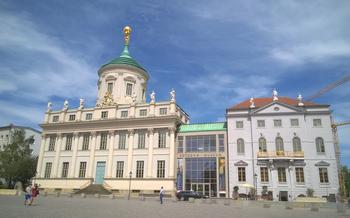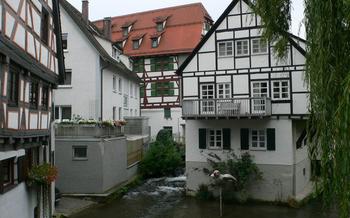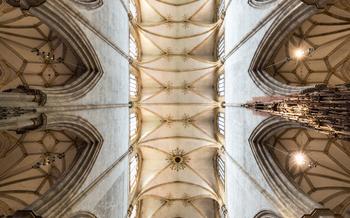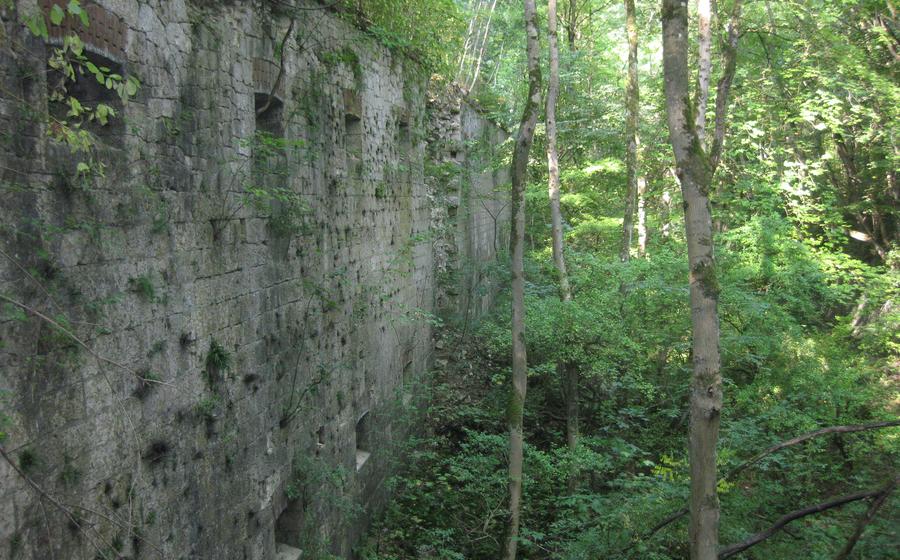
Ulm Fortress (Bundesfestung Ulm)
- The Bundesfestung Ulm
- Wilhelmsburg Fortress
- Neu-Ulm City Walls
- Friedrichsau Fortress
- The New House (Neues Haus)
- Upper Arsenal (Oberes Arsenal)
- Lower Arsenal (Unteres Arsenal)
- The Bastion
- The Powder Magazine (Pulverhaus)
- The Casemates
- Ulm Minster
- The Donau River
- The Ulm Museum
- Kunsthalle Weishaupt
- Insider Tip
The Bundesfestung Ulm
The Bundesfestung Ulm, or Ulm Fortress, is a colossal complex of fortifications built between 1842 and 1859 by the Kingdom of Württemberg to defend the city of Ulm from attack. The fortress is one of the largest and most impressive examples of 19th-century military architecture in Europe. It consists of a ring of forts, bastions, and walls that stretch for over 10 kilometers around the city.
The fortress was designed by the renowned German military engineer Moritz von Prittwitz, who also designed the fortress of Rastatt. The Ulm Fortress was built using the latest military technology of the time, including massive ramparts, moats, and underground tunnels. The fortress was also equipped with a large number of cannons and other weapons.
The Ulm Fortress was never actually used in battle, but it played an important role in the history of the city. The fortress served as a deterrent to attack and helped to keep Ulm safe during the Franco-Prussian War of 1870-187After the war, the fortress was used as a barracks for the German army. In 1945, the fortress was captured by the American army and used as a prison camp for German soldiers.
Today, the Ulm Fortress is a popular tourist attraction. Visitors can explore the fortress's many fortifications, including the Wilhelmsburg Fortress, the Neu-Ulm City Walls, and the Friedrichsau Fortress. The fortress is also home to several museums, including the Ulm Museum and the Kunsthalle Weishaupt.
Wilhelmsburg Fortress
The Wilhelmsburg Fortress, perched atop a hill overlooking the city of Ulm, stands as a testament to the city's rich military history. Constructed in the 19th century as part of the Bundesfestung Ulm, this imposing fortress served as a vital defensive bulwark during the Franco-Prussian War. Its strategic location and formidable fortifications made it a key stronghold in the region.
The Wilhelmsburg Fortress boasts an impressive architectural design, showcasing the military engineering prowess of the time. Its massive ramparts, intricate bastions, and deep moats were meticulously crafted to withstand enemy attacks. The fortress's walls, adorned with gun embrasures and loopholes, provided soldiers with vantage points to repel approaching forces.
Today, the Wilhelmsburg Fortress has been transformed into a vibrant cultural hub, hosting an array of exhibitions, events, and performances. Visitors can delve into the fortress's military past through interactive displays and guided tours, gaining insights into the lives of the soldiers who once manned its ramparts.
One of the highlights of the Wilhelmsburg Fortress is its stunning views of the surrounding landscape. From the fortress's tower, visitors can enjoy panoramic vistas of the city of Ulm, the meandering Danube River, and the picturesque Swabian countryside. The fortress offers a unique perspective from which to appreciate the region's natural beauty and rich heritage.
Neu-Ulm City Walls
The Neu-Ulm City Walls are a remarkable testament to the city's rich history and its strategic importance as a fortified town. Constructed in the 14th century, these walls once encircled the entire city, providing protection from invaders and ensuring the safety of its inhabitants.
History
The city walls of Neu-Ulm were initially built in the 14th century as part of the town's fortifications against potential attacks. Over the centuries, the walls underwent several expansions and modifications, reflecting the changing needs and threats faced by the city. During the Thirty Years' War in the 17th century, the walls were significantly strengthened to withstand the devastating conflicts that engulfed Europe at the time.
Architecture
The Neu-Ulm City Walls showcase an impressive blend of medieval and Renaissance architectural styles. Constructed primarily of red brick, the walls feature sturdy towers and bastions that provided strategic vantage points for defense. The walls also incorporated several gates, allowing controlled access to and from the city.
Current Status
Today, the Neu-Ulm City Walls stand as a preserved historical landmark, offering a glimpse into the city's rich past. While some sections of the walls have been demolished over time, significant portions remain intact, providing visitors with a tangible connection to the city's medieval heritage.
Walking Tour
Visitors to Neu-Ulm can embark on a captivating walking tour along the preserved sections of the city walls, exploring the towers, bastions, and gates that once served as the city's protective barrier. The tour provides an immersive experience, allowing visitors to appreciate the architectural details and imagine the lives of those who lived within these walls centuries ago.
Friedrichsau Fortress
The Friedrichsau Fortress is a former fortress located in the Friedrichsau park in Ulm, Germany. It was built in the 19th century as part of the Bundesfestung Ulm, a system of fortifications designed to protect the city from attack. The fortress is a well-preserved example of 19th-century military architecture and is now a popular tourist attraction.
The fortress was built between 1842 and 1859 and was designed by the Prussian military engineer Ernst Ludwig von Aster. It is a polygonal fort with six bastions and a moat. The fortress was armed with a variety of artillery pieces, including cannons, mortars, and howitzers.
The fortress was never used in combat and was decommissioned in 187It was then used as a barracks and a prison before being converted into a park in the early 20th century. The park is now a popular destination for locals and tourists alike and is home to a variety of attractions, including a playground, a beer garden, and a museum.
The fortress is a reminder of Ulm's rich military history and is a valuable example of 19th-century military architecture. It is a popular tourist attraction and is a great place to learn about Ulm's past.
The New House (Neues Haus)
The New House, or Neues Haus, is a prominent landmark in the city of Ulm. Constructed in the 16th century, this historic building boasts a rich history and architectural significance. Originally, the New House served as a granary and storage facility for the city's grain reserves. Its sturdy construction and spacious interior made it an ideal location for storing food supplies.
The New House showcases a blend of Gothic and Renaissance architectural styles. The exterior features intricate stone carvings and decorative elements, while the interior boasts high ceilings and a spacious layout. The building's design reflects the transition between medieval and Renaissance architecture, showcasing the changing artistic styles of the period.
Today, the New House houses the Ulm Museum, which features a diverse collection of exhibits showcasing the city's history, culture, and art. Visitors can explore galleries dedicated to archaeology, medieval art, and modern and contemporary art. The museum also hosts temporary exhibitions and events throughout the year.
In addition to its role as a museum, the New House also serves as a venue for concerts, lectures, and other cultural events. Its impressive acoustics and versatile interior make it an ideal location for a variety of performances and gatherings. Whether you're interested in art, history, or simply want to experience Ulm's vibrant cultural scene, the New House is a must-visit attraction.
Upper Arsenal (Oberes Arsenal)
The Upper Arsenal, or Oberes Arsenal, is a former military building in Ulm, Germany. It was built in the 16th century and served as a storage facility for weapons and ammunition, as well as a barracks for soldiers. The building was designed by the Italian architect Donato Bramante and is considered a masterpiece of Renaissance architecture.
The Upper Arsenal is a large, imposing building with a rectangular courtyard and four corner towers. It is made of red brick and has a series of arched windows and doorways. The building is decorated with a number of sculptures and reliefs, including a large eagle over the main entrance. The Upper Arsenal is currently used as a museum and houses a collection of weapons, armor, and other military artifacts. It also hosts a number of events and exhibitions throughout the year. Guided tours of the Upper Arsenal are available, and they are a great way to learn more about the history of the building and its role in the defense of Ulm.
Lower Arsenal (Unteres Arsenal)
The Lower Arsenal, or Unteres Arsenal, is another impressive building within the Bundesfestung Ulm. It was constructed between 1849 and 1854 to serve as a storage facility for artillery and ammunition. The building's robust appearance, with its thick walls and barred windows, reflects its original purpose.
Architecturally, the Lower Arsenal is a fine example of neo-Gothic style, with pointed arches, ribbed vaults, and decorative turrets. Its design is attributed to Moritz von Rauch, a prominent military engineer who played a significant role in shaping the fortifications of Ulm.
Today, the Lower Arsenal houses the Ulm City Archives, which preserve and showcase the city's rich history through a vast collection of documents, photographs, and artifacts. Visitors can explore the archives and gain insights into Ulm's past, including its role in the Swabian League, the Thirty Years' War, and the Napoleonic era.
Guided tours of the Lower Arsenal are available, providing visitors with a deeper understanding of the building's history, architecture, and current use. These tours offer a unique opportunity to delve into the fascinating world of military history and gain a glimpse into the lives of the soldiers who once occupied these storied grounds.
The Bastion
The Bastion is one of the most impressive fortifications within the Bundesfestung Ulm. It was built in the 16th century and served as a defensive position for the city of Ulm. The Bastion is a massive, triangular structure with thick walls and a deep moat. It was designed to withstand attacks from enemy artillery and infantry.
The Bastion is also a beautiful example of Renaissance architecture. The walls are decorated with intricate carvings and sculptures, and the gates are topped with ornate finials. The Bastion was once the home of the city's garrison, and it still contains a number of military buildings, including a barracks and a guardhouse.
Today, the Bastion is a popular tourist attraction. Visitors can walk along the walls and enjoy stunning views of the city and the surrounding countryside. The Bastion also hosts a number of events throughout the year, including concerts, plays, and historical reenactments.
The Powder Magazine (Pulverhaus)
The Powder Magazine, or Pulverhaus, is a significant historical landmark in Ulm, Germany. Built in the 16th century, it served as a crucial storage facility for gunpowder and other explosives used for the defense of the city. The magazine was constructed with thick walls and a sturdy design to withstand potential attacks and explosions.
Throughout its history, the Powder Magazine played a pivotal role in safeguarding Ulm's fortifications. Its strategic location within the city walls ensured that the gunpowder supply was secure and readily accessible during times of conflict. The magazine's robust construction provided protection against enemy attacks, minimizing the risk of explosions that could cause widespread damage.
Today, the Powder Magazine stands as a testament to Ulm's rich military history. It has been carefully preserved and transformed into a museum, offering visitors an immersive glimpse into the city's past. The museum's exhibits showcase the history of gunpowder production and storage, as well as the role of the magazine in Ulm's defense system.
Guided tours are available for those who wish to delve deeper into the fascinating story of the Powder Magazine. Knowledgeable guides provide insights into the magazine's construction, its strategic importance, and the role it played in shaping Ulm's history. Visitors can explore the magazine's interior, gaining a firsthand understanding of its unique architecture and the precautions taken to ensure the safe storage of gunpowder.
Whether you are a history buff, an architecture enthusiast, or simply curious about Ulm's past, the Powder Magazine is a must-visit destination. Through its well-preserved structure and informative exhibits, the magazine offers a captivating journey into the city's military heritage and the enduring legacy of its fortifications.
The Casemates
The casemates are a series of underground chambers built within the walls of the fortress. Initially, they were used for defensive purposes but later served as storage and accommodation space and as a hospital during World War II. Today, they are open to the public and offer a glimpse into the fortress's past.
The casemates consist of a series of vaulted chambers that are connected by narrow tunnels. The walls are made of thick stone, and the air is cool and damp. The chambers are mostly empty, but some have been converted into exhibition spaces or used for other purposes.
One of the most interesting casemates is the “Kasemattenmuseum,” which houses a collection of artifacts from the fortress's history. The museum includes uniforms, weapons, and other objects that were used by the soldiers who guarded the fortress.
Another interesting casemate is the “Kasemattenkino,” which shows films about the history of the fortress and the city of Ulm. The films are shown in German, but there are English subtitles available.
The casemates are a fascinating and atmospheric place to visit. They offer a unique glimpse into the history of the fortress and the city of Ulm.
Ulm Minster
The Ulm Minster is one of the most iconic landmarks in Germany. It is a stunning example of Gothic architecture and is the tallest church in the world. The construction of the minster began in 1377 and was completed in 1890. It is a UNESCO World Heritage Site and is one of the most popular tourist attractions in Ulm.
The minster is home to a number of impressive features, including its intricate carvings, stained glass windows, and vaulted ceilings. The tower of the minster offers stunning views of the city and the surrounding countryside. Visitors can climb the 768 steps to the top of the tower for a truly unforgettable experience.
The Ulm Minster is also a popular venue for concerts and other events. The acoustics in the minster are excellent, making it an ideal place to enjoy a musical performance. Guided tours of the minster are available and are a great way to learn more about its history and architecture.
The Donau River
The Donau River is one of the most important rivers in Europe, and it flows through the heart of Ulm. There are many ways to enjoy the river and its surroundings.
One popular option is to take a boat tour. There are several different companies that offer boat tours, and they range from short sightseeing cruises to longer excursions that take you to different towns and villages along the river.
If you prefer to stay on land, there are also plenty of walking and biking trails that run along the riverbank. These trails offer stunning views of the river and the surrounding countryside.
Fishing is another popular activity on the Donau River. The river is home to a variety of fish, including trout, salmon, and carp.
If you're looking for a place to cool off on a hot summer day, you can go swimming in the Donau River. There are several designated swimming areas along the river, and they're all supervised by lifeguards.
The Ulm Museum
The Ulm Museum is a must-visit for anyone interested in the rich history and culture of Ulm. Located in the heart of the city, the museum is home to a vast collection of artifacts and exhibits that tell the story of Ulm from its earliest days to the present.
The museum's collection includes everything from prehistoric tools and weapons to medieval armor and tapestries, as well as a wide range of modern and contemporary art. There are also exhibits on the city's industrial history, its role in the Reformation, and its connection to the Danube River.
One of the highlights of the museum is the Ulm Charterhouse, a 15th-century monastery that has been beautifully preserved and now houses a collection of religious art and artifacts. The museum also has a large collection of paintings by the Ulm School, a group of artists who were active in the city during the 15th and 16th centuries.
The Ulm Museum is a great place to learn about the history and culture of Ulm. The museum's exhibits are well-curated and informative, and the staff is friendly and helpful. There are also a number of guided tours available, which are a great way to learn even more about the museum's collection.
Guided tours of the Ulm Museum are available in English and German.
Insider Tip: The Ulm Museum is free to visit on the first Sunday of every month.
Kunsthalle Weishaupt
The Kunsthalle Weishaupt is a renowned art museum in Ulm, Germany, dedicated to contemporary and modern art. It was founded in 1997 and is housed in a striking building designed by renowned architect Hans Hollein. The museum's collection includes over 4,000 works of art from the 20th and 21st centuries, including paintings, sculptures, photographs, and installations.
The Kunsthalle Weishaupt is known for its innovative and thought-provoking exhibitions, which often explore cutting-edge themes and artistic practices. The museum also hosts a variety of educational programs, workshops, and events, aimed at engaging visitors of all ages with contemporary art. It is a must-visit destination for art enthusiasts and anyone interested in experiencing the latest trends in contemporary art.
Guided tours of the Kunsthalle Weishaupt are available, providing visitors with insights into the museum's collection and the significance of the artworks on display.
Insider tip: To make the most of your visit to the Kunsthalle Weishaupt, consider attending one of the museum's many special events, such as artist talks, workshops, or concerts. These events offer a unique opportunity to engage with contemporary art and artists in a more personal and interactive way.
Insider Tip
-
The best time to visit Ulm is during the summer months, when the weather is warm and sunny. However, the city is also beautiful in the winter, when it is covered in a blanket of snow.
-
Guided tour recommendations: To get the most out of your visit to the Ulm Fortress, consider booking a guided tour. Tours are available in English and German and last for about an hour.
-
Local food specialties: Be sure to try some of the local food specialties, such as Maultaschen (pasta pockets filled with meat and vegetables), Spätzle (egg noodles), and Käsespätzle (cheese noodles).
-
Unique souvenirs: If you are looking for a unique souvenir to remember your trip to Ulm, consider purchasing a piece of Ulmer Keramik (Ulm pottery). This type of pottery is made from local clay and is known for its beautiful colors and patterns.
